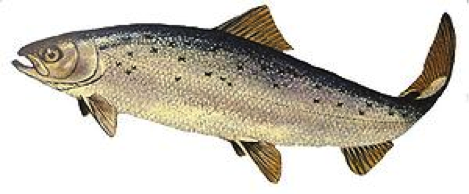
Genetically Engineered Salmon: A Soon-to-be Delice?
By Catherine Daccache
Margaret Atwood's Oryx and Crake, with its frightening visions of a future filled with comestible transgenic pigs and chickens is now far from being called fiction. The University of Guelph has already taken the first dreaded step with its Enviropig™, "a genetically enhanced line of Yorkshire pigs with the capability of digesting plant phosphorus more efficiently than conventional Yorkshire pigs." The university is competing with AquaBounty, a Massachusets-based aquafarming and biotechnology company, in the race of being the ones to introduce the first genetically engineered comestible animals into our plates. The U.S Food and Drug Administration (FDA) is on the verge of approving AquaBounty's genetically modified salmon AquAdvantage® and serve this apparently "table-ready" fish to its consumers. The only thing stopping them right now is Canada, but the question is: how much longer will it stand in their way?
 Atlantic Salmon: Image source Wikipedia
Atlantic Salmon: Image source Wikipedia
First, What Are GE Salmon?
Genetically engineered salmon are injected with a gene from the Chinook salmon, which enables them "to grow to market size in half the time of the conventional salmon" Meaning, more salmon delivered to the market in half the production time. AquaBounty Technologies, the company in charge of this new aquaculture salmon, intends to grow these salmon eggs in their facility in Prince-Edward Island and then ship them to Panama where they will grow in a land-based facility to reduce the risks of contact with wild salmon stock. Then, the fish will be sent back to the U.S where they are to be sold to the consumer market. AquaBounty does not yet have the O.K from Environment Canada and Health Canada to go ahead with this project, but it seems to be a matter of time before they do because they refuse to tell the public if they are considering the approval.
Fishing down the Food Chain?
"Some say genetic engineering was always fishy, but now the fish themselves are engineered", cleverly remarks Lucy Sharratt, coordinator of the Canadian Biotechnology Action Network (CBAN) in her article "Biotech gets Fishy with GE Salmon", published in Common Ground Magazine. CBAN is worried"bad science" is behind AquaBounty's initiative. Dr. Michael Hansen, Senior Scientist at Consumers Union US, claims that AquaBounty's practices are questionable and that the science is a bit "sloppy" CBAN and others are also worried about potential allergies arising from this new kind of genetically mutated fish.
Like Sharratt, opposers of GE salmon are also worried that GE salmon escape into the wild waters and transport disease, or even biologically change wild salmon in case breeding occurs. The results could be damaging; mutations in growth size and gene deficiencies could hinder the already fragile state of the Atlantic salmon. "Any risk of GM Atlantic salmon escaping into the wild is inacceptable", adds CBAN. Their fears are not without cause, there is already evidence that this has already happened. According to CBAN's website, this past December, the virus ISA (Infectious Salmon Anaemia) was confirmed to have been found AquaBounty's genetically modified salmon. The site was land-based and isolated from the ocean, so the question now is how were they contaminated? Officials seem to be lying low in response to this recent discovery.
"If we allow GM fish production, we will strike yet another blow against our severely endangered wild fisheries" says Eric Hoffman, of Friends of the Earth U.S He is not alone in his defence of Atlantic salmon. Populations of wild Atlantic salmon are already in a decline, and endangered fisheries are risky business. Nobody wants to be the blame for another fishery collapse. It seems as though the Atlantic Cod fishery collapse of the 1950s has left its mark.
Since the 1960s, the world's marine catch has quadrupled and the demand for fish, especially desirable species, like salmon for instance, is heavily increasing. So what now? Companies have turned to aquaculture, exactly what AquaBounty does, but in water-based facilities, where farming of fish is general practice.
Salmon farming. Image by rodc via Flickr.
Aquaculture: A Risky Alternative?
The fish farming industry, popularly referred to as aquaculture, is an industry currently valued at 800 million dollars and accounts for 14 percent of Canada's total seafood produce. Although it is advantageous in that it controls the fish population under production, it also has many negative effects on the environment. It affects coastal ecosystems and the waste generated from fish farms can also reduce dissolved oxygen levels in water, putting pressure on wild stock.
But the biggest issue with farmed salmon is that they require a high amount of protein, which is generally supplied in the form of forage fish. So, in a way, the quantity of wild fish consumed by salmon is higher than the final salmon produced by the aquaculture industry.
Also, water-based farms have had their share of mishaps with salmon escaping from their farms. This process is a very dangerous one as farmed salmon can become very invasive and out-compete native salmon. Disease can also be easily transmitted. In 1972, a parasite spread from Norwegian hatcheries and ended some wild salmon populations
So, What Now?
In the wait for officials' decision on whether to legalize consumption of GE salmon, or the EnviroPig for that matter, hopefully we won't have to face another disaster caused by human error or groundless science. And I also hope a few of them are as terrified as I am about Oryx and Crake's ending.
- Enviropig™. ©University of Guelph, 2010. www. uoguelph.ca/enviropig/
- Sharratt, Lucy. "Biotech gets Fishy with GE Salmon". Common Ground Magazine, October 2010.
- AquAdvantage Fish. AquaBounty Technologies. http://www.aquabounty.com/products/aquadvantage-295.aspx
- GE Fish. CBAN. http://www.cban.ca/Resources/Topics/GE-Fish
- "Islanders Hold the Future of Wild Atlantic Salmon in their Hands".CBAN. http://www.cban.ca/Press/Press-Releases/Islanders-Hold-the-Future-of-Wild-Atlantic-Salmon-in-their-Hands
- Wikipedia. "Aquaculture".en.wikipedia.org/wiki/Aquaculture
- Wikipedia. "Aquaculture of Salmon". en.wikipedia.org/wiki/Aquaculture_of_salmon
- Wikipedia. "Aquaculture of Salmon." en.wikipedia.org/wiki/Aquaculture_of_salmon

Leave a comment